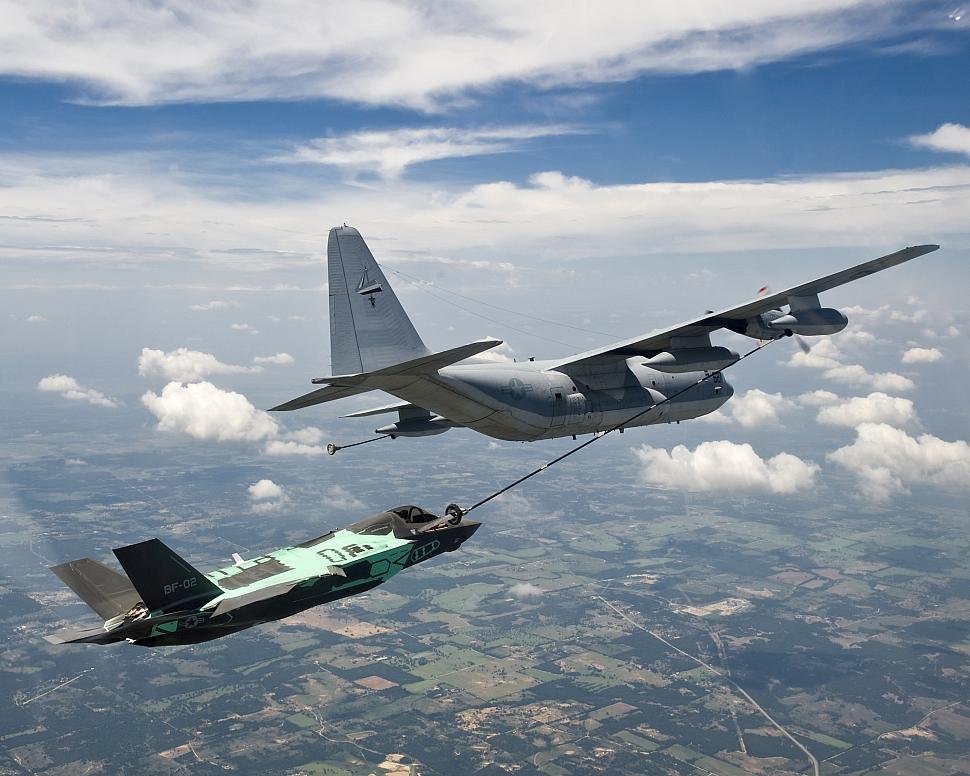Fighter Jet News
F-35 Lightning II News
F-35 successful in first probe-and-drogue aerial refueling
August 15, 2009 (by
Eric L. Palmer) -
A short takeoff/vertical landing (STOVL) variant of the F-35 Lightning II stealth fighter has become the first F-35 to complete an aerial refueling test using the Navy- and Marine Corps-style probe-and-drogue refueling system.

Thursday's successful mission is the first in a short series of tests that will clear the STOVL F-35B variant for extended-range flights, particularly to its primary test site at Naval Air Station Patuxent River, Md.
"The F-35 program is on the cusp of a tremendous expansion in flight test as a large number of new aircraft enter the test fleet this year and early next year," said Dan Crowley, Lockheed Martin executive vice president and F-35 program general manager. "This milestone will help ensure that we fill the pipeline between Fort Worth and Pax River with F-35s and maintain our flight-test tempo."
During Thursday's flight, the F-35B designated BF-2 (the second STOVL flight test aircraft), began a series of tests in which fuel is uploaded into the aircraft at 10,000, 15,000 and 20,000 feet, at speeds ranging from 200 to 250 knots. The pilot on the initial F-35B aerial refueling flight was U.S. Marine Corps Maj. Joseph T. "O.D." Bachmann.
The refueling mission also marked the first time a Lockheed Martin KC-130J tanker has been used to refuel an F-35. Since deployment to Iraq in 2005 the KC-130J has offloaded more than 186 million pounds of fuel during combat operations. Previous refueling missions with the F-35A conventional takeoff and landing variant were accomplished with a KC-135 tanker. To date, the first F-35A has received approximately 110,000 pounds of fuel during aerial refuelings.
Probe-and-drogue refueling employs a flexible hose that trails from the tanker aircraft. The basketlike drogue at the end of the hose connects to the receiving aircraft’s probe, which, in the case of the F-35, resides on the right side of the forward fuselage and retracts when not in use. The U.S. Navy, Marine Corps and the air forces of many other countries use the probe/drogue system, while the U.S. Air Force refuels its aircraft via a rigid flying boom that inserts into a receptacle on the receiving airplane.

A short takeoff/vertical landing variant of the Lockheed Martin F-35 Lightning II takes on fuel from a KC-130J tanker near Fort Worth on August 13th. The fuel transfer marked the first time an F-35 has used the Navy- and Marines-style probe-and-drogue refueling system. [Lockheed Martin photo]
"The F-35 program is on the cusp of a tremendous expansion in flight test as a large number of new aircraft enter the test fleet this year and early next year," said Dan Crowley, Lockheed Martin executive vice president and F-35 program general manager. "This milestone will help ensure that we fill the pipeline between Fort Worth and Pax River with F-35s and maintain our flight-test tempo."
During Thursday's flight, the F-35B designated BF-2 (the second STOVL flight test aircraft), began a series of tests in which fuel is uploaded into the aircraft at 10,000, 15,000 and 20,000 feet, at speeds ranging from 200 to 250 knots. The pilot on the initial F-35B aerial refueling flight was U.S. Marine Corps Maj. Joseph T. "O.D." Bachmann.
The refueling mission also marked the first time a Lockheed Martin KC-130J tanker has been used to refuel an F-35. Since deployment to Iraq in 2005 the KC-130J has offloaded more than 186 million pounds of fuel during combat operations. Previous refueling missions with the F-35A conventional takeoff and landing variant were accomplished with a KC-135 tanker. To date, the first F-35A has received approximately 110,000 pounds of fuel during aerial refuelings.
Probe-and-drogue refueling employs a flexible hose that trails from the tanker aircraft. The basketlike drogue at the end of the hose connects to the receiving aircraft’s probe, which, in the case of the F-35, resides on the right side of the forward fuselage and retracts when not in use. The U.S. Navy, Marine Corps and the air forces of many other countries use the probe/drogue system, while the U.S. Air Force refuels its aircraft via a rigid flying boom that inserts into a receptacle on the receiving airplane.
Courtesy - Lockheed Martin
Related articles:
Forum discussion:
Tags
- U.K. may drop the STOVL F-35 for carrier variant ( 2009-08-06)
- First U.S. Navy F-35 rolls out ( 2009-07-29)
- P&W awarded $571m engine contract ( 2009-07-26)
- F-35 Lightning II news archive
Forum discussion:
- Start a discussion about this article in the F-35 forum.
Tags
